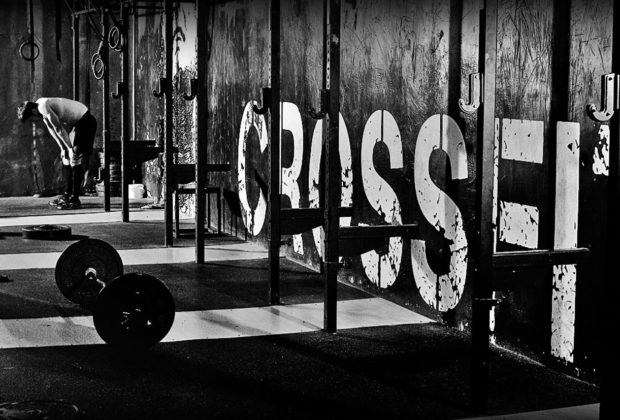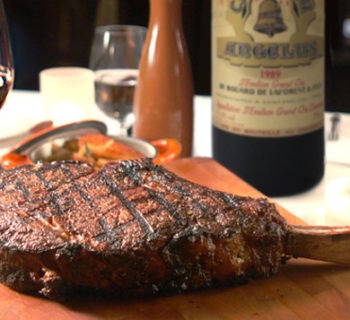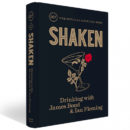INNER 007 -- CrossFit is: Constantly Varied, High Intensity, Functional Movement. After looking at all sport and physical tasks collectively, Crossfit figured out what physical skills and adaptations would be the most universally useful in any given situation. So basically, the “specialty” of Crossfit is in not specializing.
Most of what you will hear on this podcast is straight from Crossfit.com and the Crossfit Journal found there. If you’re interested in Functional Fitness, it’s a great place to start.
The definition of CrossFit is:
Constantly Varied, High Intensity, Functional Movement.
Basically, Crossfit aims to build a program that will best prepare you for any physical contingency — whether you’re 8 or 80.
After looking at all sport and physical tasks collectively, Crossfit figured out what physical skills and adaptations would be the most universally useful in any given situation. So basically, the “specialty” of Crossfit is in not specializing.
Crossfit, at its very base, is a fitness regimen developed by Coach Greg Glassman over several decades. He was the first person in history to define “fitness” in a way that is both meaningful and measurable.
The Crossfit definition of Fitness is “increased work capacity across broad time and modal domains” – I will describe what that means in a second – and again, CrossFit is defined as the program that optimizes Fitness, as defined this way.
Crossfit is also a community of people that do the WOD – which stands for Workout Of The Day – together in a box, which is Crossfit’s word for a gym. WODs are short – you’re never at the box, including warmup and cooldown, longer than an hour, and it will have been quite a workout! Sometimes it’s as short as 15-30 minutes.
Crossfit is an open source community, which means that Crossfit HQ offers an extensive amount of free content, including workouts, as well as the Crossfit Journal, on the crossfit.com website. It’s also open source because, as explained by our instructor when I obtained my Level 1 Crossfit certification, “If someone was to compete at a Crossfit competition and came to that competition without doing any of the current Crossfit workout regimes, we would pick that person’s brain and we would incorporate what he or she did as long as it’s done in a healthy, repeatable way – because we don’t believe that our way is the only way. We think it’s the best way – until someone proves us wrong – at which point, we’ll change that way.”
Often, Ironman athletes are considered the “fittest people on Earth.” I myself have of course done an Ironman, and in actuality, that is the furthest thing from the truth. When you do any sport, you are a specialist in that sport. So, when you take the Ironman for example, you can put together a 2.4 mile swim, a 112 mile bike ride, and a marathon in fewer than 17 hours. But can you climb a rope? Can you lift a heavy box over your head? Probably not.
Crossfit aims for a broad, non-specific fitness that fits what everyone needs to do, every day. Though you might say that your grandma doesn’t need to deadlift, what happens when she drives to the store, brings her groceries home, and then puts them down to put her key in the lock – now needs to lift them back up? What about “hoisting” that bag of groceries up and onto the kitchen counter? Depending upon your gramma, that’s likely a one-arm clean. What about putting a box up on a high shelf? Clean, and press. What about squatting down to the toilet, and getting back up without having to “push up” with her hands? That’s a squat.
That is why the definition of Crossfit is a training program of Constantly Varied, High Intensity, Functional Movement. A “functional” movement is one that actually does a useful function. My example was just a clean and press – picking up a box from the floor, and putting it up on a high shelf. Now, if you work out in the gym, you might work out your legs on a press machine, your biceps on a bicep machine, and your shoulders on a shoulder press. But by having done all these pieces, do you think that you could do the movement of a clean and press? Likely not – you have trained these muscles in isolation, not as a functional movement. If instead you work on a clean and press in a Crossfit gym, you will be told that it’s important to get the movement right, first; second, to be able to do the movement correctly over and over, and THEN to be able to do the movement correctly, over and over, at “intensity” – whether that’s fast, or with weight.
Crossfit has a lot of detractors, who say that people get hurt “all the time” doing Crossfit. But in actuality, what usually happens is that the person doing the workout decides not to stick to the Crossfit method of training, which is, again, get the move right, THEN get it right over and over, THEN add intensity. Instead, they see a person lifting a heavy weight, or doing the movement in a lot shorter time than they are, and they do NOT have the movement right – much less correct over and over! – and they just go for intensity. And pull something, or get hurt, and blame it on Crossfit instead of their own ego.
Going back to the Crossfit definition of Fitness – which is increased work capacity across broad time and modal domains – Crossfit is all about tracking and improving your results in a number of areas. Crossfit encompasses weight training – whether you’re doing the move with a PVC pipe or a barbell – gymnastics training, which means basically “bodyweight” moves like handstands, or even a dip or pushup or situp – and metabolic conditioning, like rowing, running, and such. The programming of Crossfit is such that Rest days are also incorporated into the training regime. Why? Because you do not build muscle when you are working out. You build it at rest. As we used to say when I was doing traithlons, Nutrition and Rest are the “4th sport” that you need to dial in right.
But what does “increased work capacity across broad time and modal domains” mean? Imagine a graph, with time on the horizontal axis, and “force” on the vertical. “Force” is your work output for a certain move. You might only be able to move a heavy weight a few times, or a minute or two. You might be able to move a lighter weight for longer. If you plot a graph of all the movements and all the times, you will get a curve, which will be high on the left – which would represent high force, low time – and lower/tapering at the right – which will represent lower force, and longer time.
Under that curve, if you were to shade it, is your “work capacity.” That is how much “work” you can do over the horizontal time, and the vertical “workout modes” axes.
And that’s what Crossfit wants to address – it wants to push that curve upwards. It wants to increase your work capacity, so that you’re able to exert more force over the same amount of time, or to exert the same amount of force over a shorter period of time.
One of the most important parts of Crossfit is that it’s measurable. When you do a WOD – remember, Workout Of The Day – your time, or weights, or however that WOD is measured is put up on a whiteboard. You’re expected to keep track of how you are doing – whether by using a software program such as BeyondTheWhiteboard.com or even an Excel spreadsheet. This will keep track of what you did that particular move at, on that particular day. More importantly, it helps you to push the work capacity curve up, because if you got to let’s say 50 pounds at the end of the WOD that day, then you’re going to aim to get to 60 pounds – or at least 51 pounds! – the next time you do that sort of movement. By keeping track, you can also see what you need to work on, and you can celebrate your successes, where you are able to move your work capacity curve upwards.
If you want to make this a bit more complex, imagine that this particular work capacity curve is for your age right now. Add a “Z” access for 3-D – which would be an axis for your age. Next year, you move forward 1 year on that Z axis. This allows you to plot your work capacity not only for that one year, but over time. You will have a three-dimensional figure that will show you your actual work capacity over not only time, but also over years.
But let’s do what Head of Section does, and help you look like you know what you’re doing the first time you approach a Crossfit Box. If you want to join a Crossfit Box, you will need to take an On-Ramp class. This class will teach you all the movements that you will be expected to know when you actually do your first WOD. It will cover how to correctly lift things, press things over your head, support your body weight, understand how to stabilize your body, and the like.
You will also learn some of the acronyms that are used in Crossfit. An “AMRAP” means As Many Repetitions As Possible – usually in a certain time frame. An “EMOM” means “Every Minute On The Minute.” So you’re given a certain amount of a workout to do – say, like 5 pushups – and you do that in a minute, and you get to rest until the minute is up. (If it takes more than a minute for you to do that thing, you don’t get the rest!) A “Tabata” is named after the coach who invented it in Japan, it’s 8 rounds of 20 seconds going as hard as you can, 10 seconds rest. A “double under” is jumping rope, with the rope passing under your feet 2 times in a single jump. An “RM” is a “rep max.” so a WOD that says “figure out your 3RM” means that you are going to be figuring out what weight you can do the movement at, 3 times only, then you fail (this will come up in a second!)
There are also set workouts in Crossfit, which are done so that you can have a benchmark that every Crossfitter worldwide has. These are either called “The Girls” because they are named after women (such as Fran), or they are called the “Hero” workouts because they are named after heroes – usually police, or military – who died protecting our freedoms. Once you’ve started doing Crossfit, you will be watching a TV show, like happened to me recently with NCIS, and a character will walk in wrecked from a workout and turn to another character and just say “Fran.” It’s a funny thing to be “in the know” about. As a communal thing, you can go to a box in another state, or county, and the coach will often ask you what your 1RM, 3RM, 5RM, or perhaps your “Fran time” is.
Why should you know this? Because, as will also be explained to you in your OnRamp course, Crossfit is all about Scaling the workout.
What does Scaling mean? It means that everyone that is doing the workout should be using the same “perceived exertion” to get that workout done.
This is the beauty of Crossfit. As I wrote on my BeABondGirl.com blog, Crossfit is a bit like golf in this. In golf, you are given a “handicap” which you get to subtract from your score at the end. So let’s say you are playing a pro golfer with a handicap of zero, and you have the highest handicap that you can get (which I believe is 42 – which happens to be MY handicap). If you play a round and the pro comes back with a score of 100, and you have a score of 141, you win. Because you get to subtract 42 from your score, and 141 minus 42 gives you 99.
So, if you walk into your Crossfit box on your first day after your OnRamp, and the WOD on the whiteboard is something that you know you can’t do, you ask the coach how to SCALE that WOD.
The whiteboard will be listing the WOD at what is called “Rx” – as in, the “prescription” weights or times. But that Rx has a presumption. That presumption is that it is a certain percentage of the perceived exertion of a standard, fit crossfitter’s time or weight for that workout.
So let’s say that you walk into the box on that “first read WOD” day, and the Whiteboard says that the WOD is to do a 7 minute AMRAP – remember, as many rounds as possible? – of 3 80 pound deadlifts, 20 pushups, and 10 pullups.
You know that 80 pounds is WAY over even your ONE rep max for deadlifts. So you ask the coach how to scale that workout, or, more particularly, what does that workout presume? You’d ask, “what percentage of my 3 rep max should that deadlift be?” And the coach might say to you something like “It’s supposed to be heavy, so that should be at least 80% of your 3 rep max.”
Maybe you don’t have a list of your weight maxes yet – because the presumption was this was your first “real WOD” at Crossfit! But ultimately you WILL have those numbers. In this particular case, as it’s your first day – tell the coach that – and she will work with you to figure out a weight that will mimic what the WOD is looking for.
But a year later, if 80 pound deadlifts are still higher than 80% of your 3 rep max, you take your 3 rep max, multiply it by .80, and THAT is what you put on your bar. Ta-da! That’s what scaling is about!
The other part of this WOD was pushups and pullups – for pushups, perhaps you are going to do fewer of them, or perhaps you are going to do them with a band slung under your belly and attached to the vertical stanchions to take some of your weight – same for the pullups – perhaps you will be slinging a band up and over the horizontal bar and putting a foot in it, so that that band is taking part of that weight.
As our mythical WOD was a 7 minute AMRAP, you will keep track of how many rounds you are able to do 3 deadlifts, 20 pushups, and 10 pullups – however those are scaled for you. And as a side note, if you don’t get a round done, when you are giving the coach your score, you give him the number of rounds that you completed, and then the number of movements you completed in the partial round. So if you happened to get through the pushups in this case but no pullups, your partial round would be 23 – 3 deadlifts and 20 pushups.
Once you’ve finished the WOD, you will want to do some mobility. Most boxes have a warm-up before the WOD, and then a warm-down or mobility – foam rolling, stretching, and the like – afterwards. Don’t forget to do this, if even for 5 minutes! It’s an important part of the workout.
Most boxes also have a workout that is before the WOD, where you are working on a skill or a lift or a movement. So that might mean that you have a 5x5 for a weight – meaning you are lifting that weight 5 times for 5 rounds, increasing the weight each time. This is how you figure out what your weight maxes are. If you fail on the final round, well, now you have your 5 rep max for that weight. Similarly, you might be asked to work on your 3 rep max, or your time for a 200 meter run, or how long you can hold a handstand against the wall. These are all skills, movements and weights that you will track and measure, to help you guage your fitness.
Not only will this help, but – again presuming that the WOD we discussed was indeed your first day - you now also have some sort of idea of what your “scaling” will look like for deadlifts, pushups, and pullups as they were presented to you today. Log that, and then work on improving it!
It’s my personal belief that Crossfit is for everyone, because it is based on functional movements that everyone must do in their daily lives. It is non-specific exercises, and you might be asked to flip a tire, or pull a sled, or climb a rope, or jump over someone lying on the ground. As long as you remember that you must get the movement exactly right (even if scaled), first, THEN doing it right over and over, second, and THEN doing it with intensity, you’ll have great results with Crossfit. As you get better at the functional movement – or, in other words, stop scaling so much – you will of necessity need to cut back on the amount you are doing or the intensity until you can work back up … but that’s the beauty of it. In no time, you will be able to do the movements as prescribed – “at Rx” – if you do them CORRECTLY and keep your ego in check. Have fun!
- Sandy Shepard











Top 5 Rejected James Bond Theme Songs
Top 5 Rejected James Bond Theme Songs
The "No Time To Die" Review